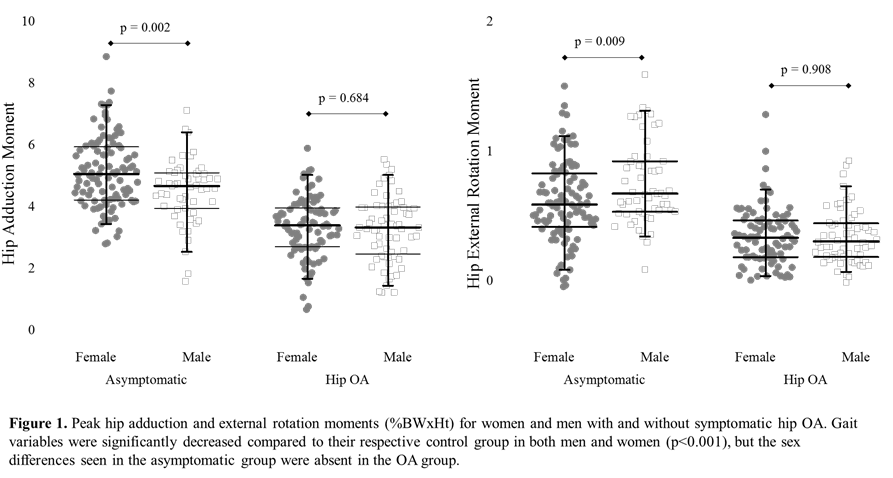Session Information
Session Type: ACR Poster Session A
Session Time: 9:00AM-11:00AM
Background/Purpose: Gait mechanics are different in healthy men and women.1 It is unknown whether or not the gait changes associated with hip osteoarthritis (OA), also differ in men and women. The goal of this study was to investigate sex differences in hip OA-related gait mechanics, using a previously described2 cohort of subjects with and without hip OA. The hypotheses tested were (1) gait kinematics and kinetics are different in asymptomatic men and women, but not in men and women with hip OA and (2) the extent of hip OA gait abnormalities are different in men and women.
Methods: An IRB-approved data repository was used to identify 150 subjects with symptomatic, radiographically-verified hip OA (age 62 ± 10, 86 F/64M, BMI 28±5) and 159 asymptomatic subjects (age 56 ± 9, 104 F/55 M, BMI 27 ± 5). All subjects had undergone gait analysis using standard published methods. The gait variables used for this study were the dynamic hip range of motion in the sagittal plane, and peak external moments about the hip in the sagittal, frontal, and transverse planes. Variables were averaged from trials collected at subjects’ self-selected normal walking speeds. Analysis of variance was used to compare gait variables for men and women, with and without hip OA.
Results: H1 – The peak hip adduction moment was higher but the peak external rotation moment was lower in healthy woman compared to healthy men (p = 0.037, p = 0.026). These differences were not seen in the hip OA group (Fig. 1.) H2 – All gait variables were lower in people with hip OA compared to healthy subjects. However, the magnitude of the OA vs healthy group difference in the peak adduction moment was 43% larger for women than men. The OA vs. healthy group difference in the peak external rotation moment was 55% larger for men than women (p < 0.001). There were no other sex-specific differences (p = 0.395-0.948).
Conclusion: Both hypotheses were supported. Sex differences in gait kinetics were seen in the healthy subjects, and were similar to those previously reported. 3,4 These differences were not preserved in subjects with hip OA. Moreover, compared to men, women with OA had greater deficits (vs. asymptomatic women) in the peak hip adduction moment, which is balanced by the hip abductors. Men, had greater deficits in the peak hip external rotation moment, which is balanced by muscles that internally rotate the hip during midstance. The hip abductors participate in this function during this phase of gait. Thus, these findings demonstrate that hip OA may result in different gait adaptations in men vs. women, particularly with respect to the role of the hip abductors. A better understanding of sex-specific gait adaptations could lead to new rehabilitation-based approaches to address the utilization and outcomes disparities in OA and THA. References: 1Ko et al., J Biomech, 44:1974-9, 2011. 2Foucher et al., J Biomech, 44:373-8, 2011. 3Moisio et al., J Biomech, 36:599-603, 2003. 4Boyer et al., J Biomech, 41:3360-5, 2008.
To cite this abstract in AMA style:
Foucher KC. Gait Abnormalities Due to Hip Osteoarthritis Are Different in Men and Women [abstract]. Arthritis Rheumatol. 2016; 68 (suppl 10). https://acrabstracts.org/abstract/gait-abnormalities-due-to-hip-osteoarthritis-are-different-in-men-and-women/. Accessed .« Back to 2016 ACR/ARHP Annual Meeting
ACR Meeting Abstracts - https://acrabstracts.org/abstract/gait-abnormalities-due-to-hip-osteoarthritis-are-different-in-men-and-women/

